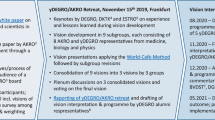Abstract
Significant advances in radiation therapy have recently been observed. Important technological advances allow for greater precision in defining target volumes and organs at risk, which will certainly impact the risk/benefit ratio for cancer care, particularly in the new setting of therapeutic associations using new drugs. Despite the major role of radiation therapy in the multidisciplinary management of several cancers, pharmaceutical industry support for radiation therapy trials that do not involve drugs remains nil. Thus, grant applications for radiotherapy studies are mainly oriented towards institutional clinical research. At the same time, research in radiation therapy has changed considerably. In France, since the beginning of the year 2000, the Cancer Institute (INCa) has considered radiation oncology modernisation as one of the health priorities. In their programs, substantial grants have been allocated to the evaluation of innovative techniques, including financial issues and their potential generalisation throughout the country. Funding for clinical research programs has also been allocated to significant projects that will impact future clinical practice. In this article, we aim to describe the various plans for restructuring radiation therapy in France, and make an inventory of the innovative projects in clinical and technology research that involve public and private institutions.
Résumé
La radiothérapie a connu un essor formidable grâce aux évolutions technologique et informatique. Il est possible de mieux définir les volumes cibles et les organes à risque et, par conséquent, d’imposer des contraintes de doses et de volumes permettant une épargne des tissus sains et une amélioration du ratio bénéfice/risque. Ce dernier pourrait se révéler primordial dans le cadre des associations aux nouvelles molécules. Dans ce contexte d’évolution, la recherche clinique et technologique en radiothérapie a connu une avancée considérable. Cependant, malgré la place capitale qu’occupe la radiothérapie dans la prise en charge multidisciplinaire de nombreux cancers, les moyens mis à sa disposition par l’industrie pharmaceutique sont incomparables à ceux dont bénéficie l’oncologie médicale. Ce support limité (voire inexistant) aux essais de radiothérapie, n’impliquant pas les traitements médicaux, contribue largement à orienter les demandes de financements vers la recherche institutionnelle. Dans le cadre du Plan cancer et sous l’impulsion de l’INCa, de nombreux projets ont vu le jour. Ainsi, parallèlement à la modernisation des plateaux techniques de radiothérapie en France, les financements alloués dans le cadre des programmes de soutien aux techniques innovantes et coûteuses (STIC) ont permis de réaliser une évaluation de nombreuses techniques de radiothérapie moderne passées en routine dans de nombreux pays dans lemonde. La radiothérapie a également bénéficiéde nombreux PHRC ayant permis une recherche clinique de pointe posant des questions pertinentes non résolues pour la pratique quotidienne. Dans cet article, nous ferons le point sur les avancées de la radiothérapie française en termes de restructuration et de projets innovants en recherche clinique et technologique dans les secteurs publics et privés.
Similar content being viewed by others
Références
Azria D, Auvray H, Barillot I, et al. (2008) Ductal carcinoma in situ: role of the boost. Cancer Radiother 12: 571–576
Bonastre J, Noël E, Chevalier J, et al. (2007) STIC IMRT 2002 Investigators. Implications of learning effects for hospital costs of new health technologies: the case of intensity modulated radiation therapy. Int J Technol Assess Health Care 23(2): 248–254
Bonastre MJ, Noël E, Bensadoun RJ, et al. (2006) The cost of intensity modulated radiation therapy in head and neck cancers: results of the 2002 STIC study. Bull Cancer 93: 1026–1032
Bondiau PY, Bénézery K, Beckendorf V, et al. (2007) CyberKnifer® obotic stereotactic radiotherapy: technical aspects and medical indications. Cancer Radiother 11: 338–344
Bondiau PY, Lallement M, Bahadoran P, et al. (2009) CyberKnife® and neoadjuvant chemotherapy for breast tumours: preliminary results. Cancer Radiother 13: 79–84
Buron C, Le Vu B, Cosset JM, et al. (2007) Brachytherapy versus prostatectomy in localized prostate cancer: results of a French multicenter prospective medico-economic study. Int J Radiat Oncol Biol Phys 67: 812–822
Charra-Brunaud C, Peiffert D (2008) Preliminary results of a French prospective-multicentric study of 3D pulsed dose-rate brachytherapy for cervix carcinoma. Cancer Radiother 12: 527–531
Haie-Meder C, Peiffert D (2006) Innovation in gynaecological brachytherapy: new technologies, pulse dose-rate brachytherapy, image, definition of new volumes of interest and their impact on dosimetry: application in a clinical research programme “STIC”. Cancer Radiother 10: 402–409
Kantor G, Mahé MA, Giraud P, et al. (2007) French national evaluation for helicoidal tomotherapy: description of indications, dose constraints and set-up margins. Cancer Radiother 11: 331–337
Lartigau E, Mirabel X, Prevost B, et al. (2009) Extracranial stereotactic radiotherapy: preliminary results with the CyberKnife®. Onkologie 32: 209–215
Marchal C, Bensadoun RJ, Haslé E, et al. (2003) Intensity modulated radiotherapy (IMRT) in France: the boost of the national funding for the new expensive innovative technologies (STIC 2001 and 2002). Cancer Radiother 7(Suppl 1): 44s–48s
Marchal C, Lapeyre M, Beckendorf V, et al. (2004) Preliminary results of the assessment of intensity modulated radiotherapy (IMRT) for prostatic and head and neck tumors (STIC 2001). Cancer Radiother 8(Suppl 1): S121–S127
Simon L, Giraud P, Dumas JL, et al. (2007) Practical recommendations for breathing-adapted radiotherapy. Cancer Radiother 11: 214–224
Author information
Authors and Affiliations
Corresponding author
About this article
Cite this article
Belkacémi, Y., Denis, F., Hannoun-Levi, J.M. et al. Innovations et recherche en radiothérapie en France. Oncologie 11, 337–342 (2009). https://doi.org/10.1007/s10269-009-1087-4
Received:
Accepted:
Published:
Issue Date:
DOI: https://doi.org/10.1007/s10269-009-1087-4




